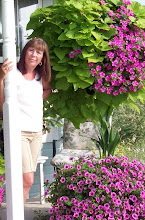
Kohlrabi (cole-rah-bee), like all other cole crops, developed from the wild cabbage, Brasscia Oleracea. This particular vegetable was introduced to the United States in the very early 1800's. It's name is derived from kohl meaning cabbage and rabi meaning turnip, thus being termed the turnip cabbage. Most often thought of as a root vegetable and/or a bulb, it is neither. The kohlrabi is merely the swollen part of the stem that forms just above the ground. I'm not a botanist so that's as far as I go in trying to inform on this vegetable. To say the least, it is by far the most unique of the cole crops.
What I know about this vegetable from firsthand experience: It will grow in a relatively small amount of space. In early June, I'd run to Sutherlands for something---possibly (probably) mulch---and I noticed at least a dozen long trays of this leafy seedling sitting off to the side of one rack being ignored. If two four packs had been purchased by another that might have been an over estimate. Quite simply, most people didn't know what it was and weren't buying. I always end up with a spot here and a spot there in my vegetable garden that is bare. Usually I plant herbs in those spots but last year, after a pang of sympathy for the abandoned seedlings, I purchased 6 four packs of kohlrabi and took them home and planted them. And yes, my sympathy pangs were more plentiful than the bare spots in my garden. That's okay, I just crowded them in. I wasn't sure they'd do anything, being a cole crop planted in midsummer. Not only did they grow, they prospered. If you don't eat a lot of cabbage, buy a four pack and call it good. This little veggie is remarkably productive.
Within a month of planting, they were ready for harvest. (Kohlrabi should be harvested when it is around three inches in circumference or it tends to get tough. I let them get about as big as my fist.) So what to do with them? They are just as versatile as the cabbage. Eaten raw, most people choose a side and say they either taste like a cabbage or a turnip. They have the solid structure of the turnip with a slightly more cabbage-like taste in my opinion, thus why I subtitled this posting the layerless cabbage. Another real plus for any vegetable is the quantity of storage time. Again, the kohlrabi is remarkably hardy and long lasting when properly refrigerated.
I know that every time I took some to the food pantry for donation, I was told later the kohlrabi were the first vegetables to go. Once people try them, they love them. Nutritionally speaking, the kohlrabi is low in sodium and (hoorah!!!) low in calories while being a great source of Vitamin C and Potassium.
FYI: The kohlrabi can be eaten raw but is equally good steamed, stir fried, boiled (as a vegetable added to soup) and grated (as for slaw). Cut into one inch cubes and properly blanched it can also be frozen and then used later in soups and stews.





